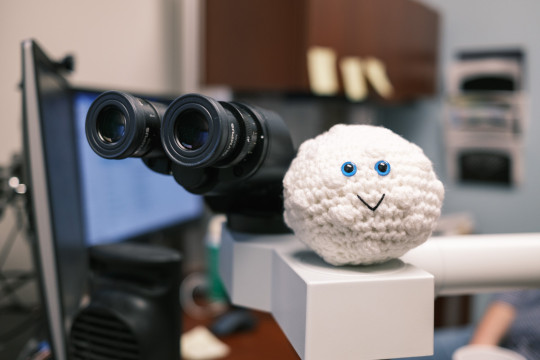A program being developed in the IWK Health hematopathology lab is offering a unique experience to patients who have a leukemia diagnosis. The Cellfie Project invites patients and their families to visit the lab to look at their own blood cells for a better understanding of their diagnosis.
Dr. David Conrad, head of the division of hematopathology at IWK Health, developed the project to connect with patients and families and take some of the uncertainty out of their difficult journey.
“The discussions that evolve during the visits really highlight how poorly understood these diagnoses can be, not because of how complicated they are, but because it can be very difficult to process the details of such a diagnosis,” says Conrad.
Before Conrad brings patients into the lab, he reviews their pathology so he can take pictures of their blood and bone marrow cells. These are the patients’ ‘cellfies’. He takes pictures of all the normal cells, and labels them so it is clear what their function is in the body. He also takes pictures of the leukemia cells so the patients can see how those cells are different, and how they can make you sick. Whenever possible, he will show pictures of their cells before and after chemotherapy to show that the leukemia cells have been eliminated.
Julie Bourgeois’ son Liam was diagnosed with leukemia in July 2021. He is now in remission and undergoing maintenance chemotherapy until Nov 2024.
“As we continued treatments we told Liam, you are in remission which means you have no cancer right now, but we have to keep treating just to make sure it doesn’t return,” says Bourgeois. “Dr. Conrad showed him the cells and explained how they functioned and which ones were the cancer cells, and then showed him a slide where there were no more cancer cells and at that point it clicked for Liam.”
Seeing, and not just being told, that leukemia cells have disappeared, and normal cells are reappearing after chemotherapy emphasizes that treatment is working.
“The first slide Dr. Conrad showed us 90 per cent of the cells were cancerous’” says Bourgeois. “And then to see the slide a month after treatment showing that it was in full remission. It’s incredible how the cells can get rid of the bad and start being good again!”
A visit with Conrad in the lab makes the patient an honorary pathologist. They receive a lab coat as well as a stuffie of a cell that turns from a bad cancer cell to a good white blood cell. They end the visit with a tour of the whole lab so they can see all the people who help run IWK diagnostic services, and thus played a role in their own diagnosis. They are also sent home with a USB drive of their cell pictures, which Conrad calls a ‘Cellfie’ stick.
“Some of the patients have shown their pictures to their classmates when they returned to school,” says Conrad. “I think there is an element of empowerment gained by learning about the diagnosis.”
“They are not easy things to talk about with an 8-year-old,” says Bourgeois. “It’s heavy but it can help just having a little bit of knowledge about what’s happening. We have never shied from what was happening with Liam. He trusts us and it was a good way for us to keep that communication open.”
“By the time the patient and their family see me, they know their diagnosis and have started treatment and are well enough to come to the lab,” says Conrad. “I see how much it means to them to have their questions answered. It feels like I am able to do more than just diagnose leukemia – I feel I am able to have a positive influence in the patient’s difficult journey and provide a level of comfort that comes with having a better understanding of their diagnosis.”
International Childhood Cancer Day is observed on February 15 every year to raise awareness of childhood cancer and to honour all the children and families experiencing the effects of the disease.
